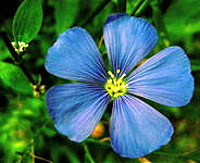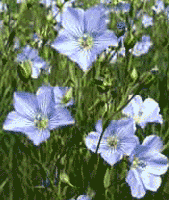|
|
|
|
Introduction
Flax or linseed, a binomial name: Linum usitatissimum is a plant that has been around for 5,000 years. The ancient Egyptians used the inside of its stem to make linen cloth. Flaxseed has also been pressed to make oils for industrial use. Whole seeds have been fed to animals and consumed by people the world over. Flax is grown both for its seeds and for its fibers.
Flax is one of those plants that has many uses: As a flower, for health and medicinal use, a grain crop, making fabrics, and
in home gardens as "True Blue" flowers. Flax originated in India.
People used the seed for food and
nutrition, and to make linseed oil. They used the fibers of the long, thin stems to make clothing, linen and lace. It was also used to make rope, twine, and a variety of other items. Flax is also called Linseed.
Flax is nature's richest source of omega-3 fatty acid. |

Blue flowers of
Flax |
|
Flax plant
Flax is an erect annual plant growing to 1.2 m tall, with slender stems.
The leaves are glaucous green, slender lanceolate, 20-40 mm long and 3 mm broad. The
flowers are pure pale blue, 15-25 mm diameter, with five petals. The fruit is a
round, dry capsule 5-9 mm diameter, containing several glossy brown seeds shaped
like an apple pip, 4-7 mm long. Clumps of delicate foliage give way to true blue flowers in the summer.
They are commonly used as a wildflower. Flax is easy to grow. As wildflowers, they require little care. In the home garden,
mulch around them to help retain soil moisture, and to keep the weeds down. Prune plants to promote good air circulation.
Types of Flax
There are two main types of flax grown worldwide: fibre flax and seed flax. These two types of flax have radically different
applications. Fibre flax is mainly grown in Europe today. It is used primarily for retting agricultural fields and small bodies of water as well as creating fabrics and threads used in upholstery, fish nets and
twine.
Seed flax is grown worldwide for its oilseed. The seed is grown for human and animal consumption. The oils can be consumed and used to manufacture paints, varnishes, linoleum, oilcloths, printing inks, soaps, and numerous other products. The seed meal that remains after the seeds have been pressed for oil are high in protein and can be used to enrich livestock feeds.
|

Flax leaves are glaucous green, slender
lanceolate, 20-40 mm long and 3 mm broad. The
flowers are pure pale blue, 15-25 mm diameter, with five petals.
|
|
Cultivation
The major fibre flax-producing
countries are Canada, USA and China, though there is also significant
production in India and throughout Europe. The most suitable soils for
flax, are deep friable loams, and containing a large proportion of
organic matter. Heavy clays are unsuitable.
Flax are grown from seeds. Flax prefer rich soil to grow. Mix in compost when planting, if your soil is not rich. Keep the soil moist, not wet. Add a general purpose fertilizer when planting them, then once a month after that.
Within six
weeks of sowing, the plant will reach 10-15 cm in height, and
will grow several centimetres per day under its optimal growth
conditions, reaching 70-80 cm within fifteen days. Flax is harvested
for fibre production after approximately 100 days, a month after the
plant flowers and two weeks after the seed capsules form. The base of
the plant will begin to turn yellow; if the plant is still green the
seed will not be useful, and the fiber will be underdeveloped. The
fiber degrades once the plant is brown. The mature plant is pulled up
with the roots (not cut), so as to maximize the fiber length. After
this the flax is allowed to dry, the seeds are removed, and is then
retted. Dependent upon climatic conditions, characteristics of the
sown flax and fields, the flax remains in the ground between 2 weeks
and 2 months for retting. As a result of alternating rain and the sun,
an enzymatic action degrades the pectins which bind fibres to the
straw. The farmers turn over the straw during retting to evenly rett
the stalks. When the straw is retted and sufficiently dry, it is
rolled up. It will then be stored by farmers before scutching to
extract fibres.
Flax grown for seed is allowed to mature until the seed
capsules are yellow and just starting to split; it is then harvested
by combine harvester and dried to extract the seed.
Insect and
Disease
Flax is susceptible to a wide variety of fungal diseases, blights and rusts. Pruning plants to increase air circulation, keeping water off the plant, and promoting overall health will help to minimize plant disease. Treat as needed with a fungicide.
|
|
|
Flax seeds
Flax seeds come in two basic varieties, brown and yellow or golden, with most
types having similar nutritional values and equal amounts of short-chain omega-3
fatty acids. The yellow flax called Linola or solin,
which has very low in omega-3. Flax seeds produce a vegetable oil known as flaxseed or linseed
oil; it is one of the oldest commercial oils and solvent-processed flax seed oil
has been used for centuries as a drying oil in painting and varnishing.
Excessive consumption of flax seeds can cause diarrhea. Flax seeds are chemically stable while whole, and milled flaxseed can be stored
at least 4 months at room temperature with minimal or no changes in taste,
smell, or chemical markers of rancidity.
Threshing: Threshing is the process of removing the seeds from the rest of the plant.
The process is divided into two parts: the first part is intended for the
farmer, or flax-grower, to bring the flax into a fit state for general or common
purposes. This is performed by three machines: one for threshing out the seed,
one for breaking and separating the straw (stem) from the fibre, and one for
further separating the broken straw and matter from the fibre. In some cases the
farmers thrash out the seed in their own mill and therefore, in such cases, the
first machine will be unnecessary.
The second part of the process is intended for the manufacturer to bring the
flax into a state for the very finest purposes, such as lace, cambric, damask,
and very fine linen. This second part is performed by the refining machine only.
|
|
|
Flax Fiber
Flax fibers are amongst the oldest fiber crops in the world.
fiber is soft, lustrous and flexible. It is stronger than cotton fiber but less
elastic. The best grades are used for linen fabrics such as damasks, lace and
sheeting. Coarser grades are used for the manufacturing of twine and rope. Flax
fiber is also a raw material for the high- quality paper industry for the use of
printed banknotes and rolling paper for cigarettes. Flax mills for spinning
flaxen yarn were invented by John Kendrew and Thomas Porthouse of Darlington in
1787.
Before the flax fibers can be spun into linen, they must be separated from
the rest of the stalk. The first step in this process is called "retting".
Retting is the process of rotting away the inner stalk, leaving the outer fibres
intact. At this point there is still straw, or coarse fibers, remaining. To
remove these the flax is "broken", the straw is broken up into small, short
bits, while the actual fiber is left unharmed, then "scutched", where the
straw is scraped away from the fiber, and then pulled through "hackles", which act
like combs and comb the straw out of the fiber.
There are several methods of retting flax. It can be retted in a pond, stream,
field or a container. When the retting is complete the bundles of flax feel soft
and slimy, and quite a few fibres are standing out from the stalks. When wrapped
around a finger the inner woody part springs away from the fibres.
Dressing the flax: Dressing the flax is the term given to removing the straw from the fibers. It
consists of three steps, breaking, scutching, and heckling. The breaking breaks
up the straw, then some of the straw is scraped from the fibers in the scutching
process, then the fiber is pulled through heckles to remove the last bits of
straw.
Uses of Flax
Ideal Food: Flax seeds
contain a high quality protein and rich in soluble fiber. The combination of the oil and the fiber makes flaxseeds an ideal laxative. Flax seeds contain vitamins B1, B2, C, E, and carotene. These seeds also contain iron, zinc, and trace amounts of potassium,
magnesium, phosphorus, calcium, vitamin E and carotene. Flax seeds contain over a hundred times more of a
phytonutrient, known as lignin, than any of its closest competitors, such as wheat bran, buckwheat, rye, millet, oats, and soybeans.
In addition to nutritious fats, flax seeds contain other nutrients which make eating the whole seed superior to consuming just the extracted oil. Flax seed promotes cardiovascular health. The high levels of omega-3 fatty acids helps to lower LDL (bad) cholesterol levels. Other benefits show that flax seed may also help lower blood triglyceride and blood pressure. It may also keep platelets from becoming sticky therefore reducing the risk of a heart attack. Its high content of alpha linolenic acids has made the ancient flax seed become our modern miracle food. Alpha linolenic acid is a type of plant-derived omega 3 fatty acid, similar to those found in fish such as salmon.
Medicinal use: Flax seeds contain high levels of lignans and Omega-3 fatty acids. Lignans may
benefit the heart, possess anti-cancer properties and studies performed on mice
found reduced growth in specific types of tumours. Initial studies suggest that
flaxseed taken in the diet may benefit individuals with certain types of
breast and prostate cancers. Flax may also lessen the severity of
diabetes by stabilizing blood-sugar levels. There is some support for the use
of flax seed as a laxative due to its dietary fiber content though excessive
consumption without liquid can result in intestinal blockage.
Flax provides fats that are precursors for brain building. Flax seed benefits patients who seem to have dry skin or
eczemaand helps to lessen the severity of diabetes by stabilizing blood-sugar levels.
Its oil high in essential fatty acids, increases the body's metabolic rate, helping to
weight control programs. Flax has been scientifically proven to treat some cases of depression, can improve the mental function of many old age, can help in the treatment of Multiple Sclerosis, proven to improve the behavior of Schizophrenics.
Raw flax seed contains the chemical hydrogen cyanide (HCN) or cyanogenic
glucosides which can be toxic if consumed in large quantities.
|
|
|

